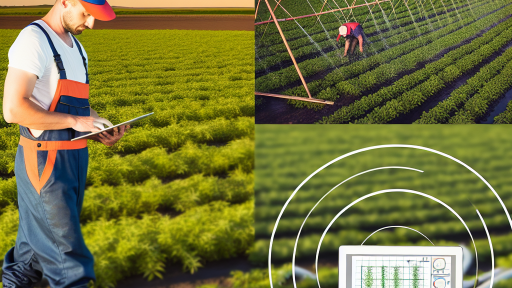Understanding Carbon Footprint in Agriculture
Defining Carbon Footprint
The carbon footprint measures the total greenhouse gas emissions caused directly or indirectly by an activity.
In agriculture, this concept includes emissions from farming practices, livestock, and land use changes.
Importance of Carbon Footprint in Agriculture
Reducing the carbon footprint is crucial for mitigating climate change.
Agriculture contributes significantly to global greenhouse gas emissions.
Thus, sustainable practices can help lower emissions and protect the environment.
Impact on Food Production
A reduced carbon footprint can enhance food security.
It enables producers to meet the increasing global food demand sustainably.
Additionally, sustainable practices can lead to healthier food choices for consumers.
Economic Advantages
Reducing emissions can also lead to cost savings for farmers.
Efficient practices often lower input costs, increasing profit margins.
Ultimately, this shift can create new economic opportunities within rural communities.
Transitioning to Sustainable Practices
Adopting sustainable practices requires education and resources.
Farmers need support to implement effective carbon management techniques.
Moreover, collaboration among stakeholders can drive these initiatives forward.
Understanding Carbon Sequestration
Definition of Carbon Sequestration
Carbon sequestration refers to the process of capturing and storing atmospheric carbon dioxide.
Transform Your Agribusiness
Unlock your farm's potential with expert advice tailored to your needs. Get actionable steps that drive real results.
Get StartedThis process is vital for mitigating climate change.
It occurs naturally through various ecological processes.
Additionally, human activities can enhance carbon sequestration in different settings.
Mechanisms of Carbon Sequestration
There are several mechanisms through which carbon sequestration takes place.
Firstly, photosynthesis plays a crucial role in capturing carbon dioxide.
Plants absorb CO2 from the atmosphere and convert it into organic compounds.
Grasslands and forests serve as significant carbon sinks.
Soi Sequestration
Sandy and clay soils can store carbon through organic matter accumulation.
Microbial activity in soil contributes to this process.
Additionally, practices like no-till farming can enhance soil carbon storage.
Aquatic Sequestration
Aquatic ecosystems also facilitate carbon sequestration.
Wetlands and ocean systems absorb carbon through plant processes.
These environments often sequester carbon in sediments over long periods.
Importance of Carbon Sequestration
Carbon sequestration helps mitigate the effects of climate change.
Furthermore, it enhances soil fertility and agricultural productivity.
By increasing the amount of carbon stored, we improve ecosystem resilience.
This process ultimately supports biodiversity and sustains our environment.
The Role of Soil Health in Carbon Sequestration
Understanding Soil Composition
Ssoil is a complex ecosystem composed of minerals, organic matter, and microorganisms.
Each component plays a vital role in supporting plant life.
Healthy soil retains more carbon than degraded soil.
This carbon retention contributes to reducing greenhouse gases.
Importance of Microbial Activity
Microorganisms help decompose organic matter, returning nutrients to the soil.
This process enhances soil structure and fertility.
Healthy microbial communities can significantly increase carbon sequestration rates.
Showcase Your Farming Business
Publish your professional farming services profile on our blog for a one-time fee of $200 and reach a dedicated audience of farmers and agribusiness owners.
Publish Your ProfilePractices That Improve Soil Health
Agricultural practices directly influence soil health.
Implementing crop rotations prevents nutrient depletion.
Cover cropping protects soil from erosion while adding organic matter.
Reduced tillage preserves soil structure and moisture content.
These practices collectively promote a sustainable way to enhance carbon storage.
The Benefits of Improved Soil Health
Healthy soil not only sequesters carbon but also supports biodiversity.
This biodiversity can improve pest resistance and crop resilience.
Moreover, it enhances water retention in the soil.
Farmers benefit from increased crop yields and reduced input costs.
Challenges to Achieving Soil Health
Despite its benefits, achieving soil health faces various challenges.
Urbanization and industrial practices degrade soil quality.
Knowledge gaps among farmers hinder the adoption of best practices.
Additionally, climate change presents ongoing threats to soil ecosystems.
Community and Policy Support
Local communities can foster soil health through education and resources.
Organizations like the Soil Health Partnership provide essential training.
Moreover, supportive policies can incentivize farmers to implement sustainable practices.
Government subsidies for cover crops are an example of this support.
Delve into the Subject: Effective Carbon Sequestration Methods for Farms
Agricultural Practices That Enhance Carbon Sequestration
Cover Cropping
Cover cropping significantly boosts soil health and fertility.
This practice reduces soil erosion while improving moisture retention.
Additionally, cover crops absorb excess carbon dioxide from the atmosphere.
Farmers like Susan Miller successfully use this method to enrich their fields.
No-Till Farming
No-till farming protects the soil structure and prevents erosion.
This technique reduces the release of carbon into the atmosphere.
By leaving crop residues on the field, it enhances soil organic matter.
For example, David Green’s farm has seen a marked improvement in soil quality.
Agroforestry Practices
Integrating trees into agricultural landscapes offers numerous benefits.
Trees capture significant amounts of carbon dioxide over their lifetimes.
They also provide shade and habitat for various species.
Farmers like Emily Johnson combine cattle and trees for optimal land use.
Organic Farming Methods
Organic farming avoids synthetic fertilizers and pesticides.
This approach promotes healthier soil microbiomes and greater carbon retention.
Farmers such as Tom Wilson focus on composting to enhance soil nutrients.
Harvesting without chemical interventions fosters a natural balance.
Rotational Grazing
Rotational grazing helps manage pasture effectively.
This practice allows grass to recover, improving root depth and carbon storage.
Farmers like Nancy Roberts rotate livestock regularly to achieve these advantages.
It not only enhances soil health but also increases biodiversity.
Enhanced Agricultural Techniques
Many farmers adopt precision agriculture technologies in their practices.
These technologies optimize resource use and minimize waste.
Showcase Your Farming Business
Publish your professional farming services profile on our blog for a one-time fee of $200 and reach a dedicated audience of farmers and agribusiness owners.
Publish Your ProfileBy monitoring soil health and moisture levels, they can make informed decisions.
Farmers such as Michael Lee invest in drones and sensors to enhance productivity.
Gain More Insights: Benefits of Crop Rotation and Diversity in Farming
The Impact of Cover Crops on Soil Carbon Storage
Understanding Cover Crops
Cover crops are plants grown to protect and enhance soil health.
Farmers use them primarily during the off-season.
They provide numerous benefits for soil structure and fertility.
Mechanisms of Carbon Sequestration
Cover crops contribute to carbon sequestration through photosynthesis.
They capture atmospheric CO2 and store it in biomass.
When cover crops decompose, they transfer carbon to the soil.
Benefits of Increased Soil Carbon
Higher soil carbon content improves soil health and fertility.
This enhances microbial activity and nutrient availability.
Additionally, it boosts soil structure and water retention.
Types of Effective Cover Crops
- Legumes, such as clover and vetch, fix nitrogen in the soil.
- Grasses, like rye and oats, build organic matter quickly.
- Brassicas, such as radishes, help break up compacted soils.
Challenges and Considerations
Farmers face certain challenges when integrating cover crops.
These may include management practices and initial costs.
However, the long-term benefits often outweigh these challenges.
Case Studies of Successful Implementation
Many farmers across the globe have successfully used cover crops.
For instance, Sarah Thompson of Oak Valley Farms reported a 30% increase in soil carbon.
Her approach involved alternating cover crops each season.
This strategy proved effective in enhancing soil fertility and crop yield.
Explore Further: Expert Pest Control Services in El Paso by Hirby Pest Control Since 1974
Integrating Livestock Grazing with Carbon Sequestration Strategies
The Importance of Grazing Management
Grazing management plays a crucial role in carbon sequestration.
Well-planned grazing can enhance soil health significantly.
This process promotes the growth of deep-rooted plants.
Deep-rooted plants increase organic matter in the soil.
As a result, they help to sequester more carbon over time.
Utilizing Cover Crops
Cover crops can improve soil structure and nutrient cycling.
They provide ground cover, preventing erosion and nutrient loss.
Additionally, cover crops enhance photosynthesis, capturing more CO2.
Integrating cover crops into grazing systems boosts biodiversity.
This practice stimulates soil microbial populations.
Rotational Grazing Practices
Rotational grazing optimizes pasture health and productivity.
This method reduces overgrazing by allowing rest periods for plants.
As a result, grasslands can recover and increase carbon storage.
Additionally, rotational grazing encourages nutrient-rich soil.
Healthier soil helps in capturing and storing more carbon.
Collaboration with Research and Local Experts
Farmers should collaborate with agricultural experts.
Local research institutions provide valuable insights and techniques.
These collaborations can lead to innovative grazing practices.
Furthermore, adopting scientifically backed strategies enhances outcomes.
As a result, farmers can improve both productivity and sustainability.
Showcase Your Farming Business
Publish your professional farming services profile on our blog for a one-time fee of $200 and reach a dedicated audience of farmers and agribusiness owners.
Publish Your ProfileMonitoring and Assessment
Regular monitoring of soil health is essential.
Farmers should measure carbon levels and biological activity.
This data helps to evaluate the effectiveness of practices.
Adjusting methods based on feedback can optimize outcomes.
Lastly, continuous assessment supports long-term sustainability goals.
Uncover the Details: Eco-Conscious Waste Solutions for Sustainable Farms

Technological Innovations in Monitoring and Enhancing Carbon Sequestration
Utilizing Remote Sensing Technologies
Remote sensing technologies revolutionize agriculture by providing critical data.
These tools collect information on soil health and vegetation density.
The data helps farmers implement effective carbon sequestration practices.
Additionally, satellite imagery assists in monitoring changes over time.
This information allows for timely adjustments in management strategies.
Implementing Precision Agriculture
Precision agriculture significantly enhances efficiency in farming operations.
This approach uses GPS technology to optimize field-level management.
Farmers can apply inputs precisely where needed, reducing waste.
As a result, soil health improves, leading to enhanced carbon sequestration.
Furthermore, precision agriculture increases crop yields sustainably.
Integrating Soil Health Monitoring
Soyl health is vital for carbon sequestration in agricultural settings.
Technological tools now measure soil organic carbon levels accurately.
Farmers can track improvements, making informed decisions on practices.
Regular monitoring identifies areas needing amendments or cover crops.
This proactive management fosters healthier ecosystems and carbon sinks.
Leveraging Data Analytics
Data analytics plays a crucial role in modern agriculture.
Farmers utilize big data to forecast and analyze soil and crop conditions.
This analysis supports decisions that enhance carbon sequestration efforts.
Moreover, predictive modeling aids in assessing long-term sustainability.
By integrating analytics, farmers improve resource allocation and yield.
Adopting Innovative Carbon Farming Practices
Carbon farming introduces practices that sequester more carbon in soil.
Techniques include cover cropping, reduced tillage, and agroforestry.
These methods enhance soil structure and organic matter content.
Consequently, farmers notice increased resilience and productivity.
Implementing these practices requires continuous learning and adaptation.
The Economic Benefits of Reducing Carbon Footprint through Sequestration
Understanding Carbon Sequestration
Carbon sequestration involves capturing and storing carbon dioxide in the soil.
This process mitigates climate change effects while enhancing soil health.
Farmers can utilize various agricultural practices to increase carbon levels in their fields.
Cost Savings in Agriculture
Implementing carbon sequestration practices leads to significant cost savings.
Firstly, healthier soils improve crop yields, reducing the need for fertilizers.
Secondly, carbon-rich soils retain more moisture, lowering irrigation costs.
In essence, these practices can lead to more efficient resource use.
Access to New Revenue Streams
Farmers can tap into carbon markets to sell carbon credits.
This not only provides additional income but also promotes sustainable farming practices.
Showcase Your Farming Business
Publish your professional farming services profile on our blog for a one-time fee of $200 and reach a dedicated audience of farmers and agribusiness owners.
Publish Your ProfileMoreover, many organizations offer financial incentives for carbon reduction efforts.
These opportunities can enhance farm profitability significantly.
Long-term Economic Stability
Integrating carbon sequestration practices leads to better long-term economic stability.
By adopting these methods, farmers can future-proof their operations against climate variability.
Enhanced resilience ensures consistent production over time.
Additionally, reduced dependence on synthetic inputs supports sustainable practices.
Increased Market Demand
Consumers increasingly favor products produced through sustainable methods.
As a result, sustainable farms often benefit from premium pricing.
This growing market offers farmers a competitive edge in the marketplace.
Consequently, sustainable practices create a win-win for farmers and the environment.
Government Policies and Incentives Supporting Carbon Sequestration in Agriculture
Overview of Current Policies
Governments worldwide are implementing policies to support carbon sequestration in agriculture.
These policies aim to reduce greenhouse gas emissions from farming practices.
Each initiative targets soil health and carbon capture through various methods.
Incentives for Farmers
Financial incentives encourage farmers to adopt carbon sequestration practices.
Grants, tax credits, and subsidies support farmers in transitioning to sustainable methods.
Programs like the Environmental Quality Incentives Program provide essential funding.
Direct payments reward farmers for implementing practices that sequester carbon.
Research and Development Initiatives
Government-funded research is vital to advancing carbon sequestration techniques.
Collaborations with universities and NGOs help develop innovative solutions.
These projects often focus on improving soil management and crop selection.
Future agricultural practices will depend on the outcomes of this research.
Education and Outreach Programs
Educational programs aim to raise awareness about carbon sequestration benefits.
Workshops and seminars provide farmers with the knowledge necessary to adopt best practices.
Extension services often play a key role in disseminating information to rural communities.
International Agreements and Collaboration
Global agreements are also influencing national policies on carbon sequestration.
Countries collaborate to share knowledge and technologies for sustainable practices.
These partnerships enhance efforts to combat climate change collectively.
Additional Resources
Statements of Support for the Agriculture Resilience Act | U.S. …




